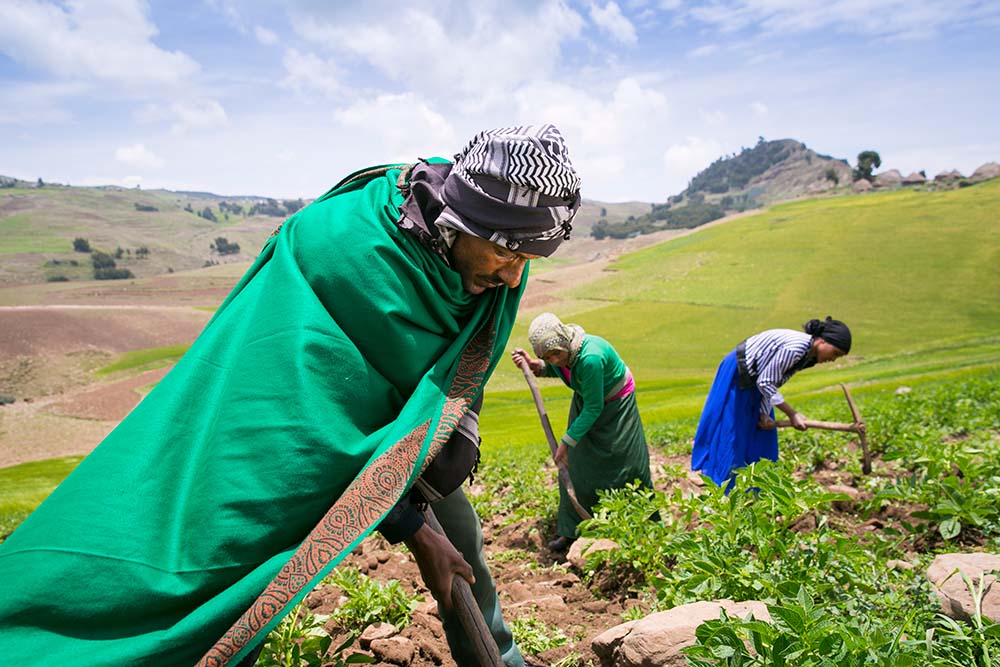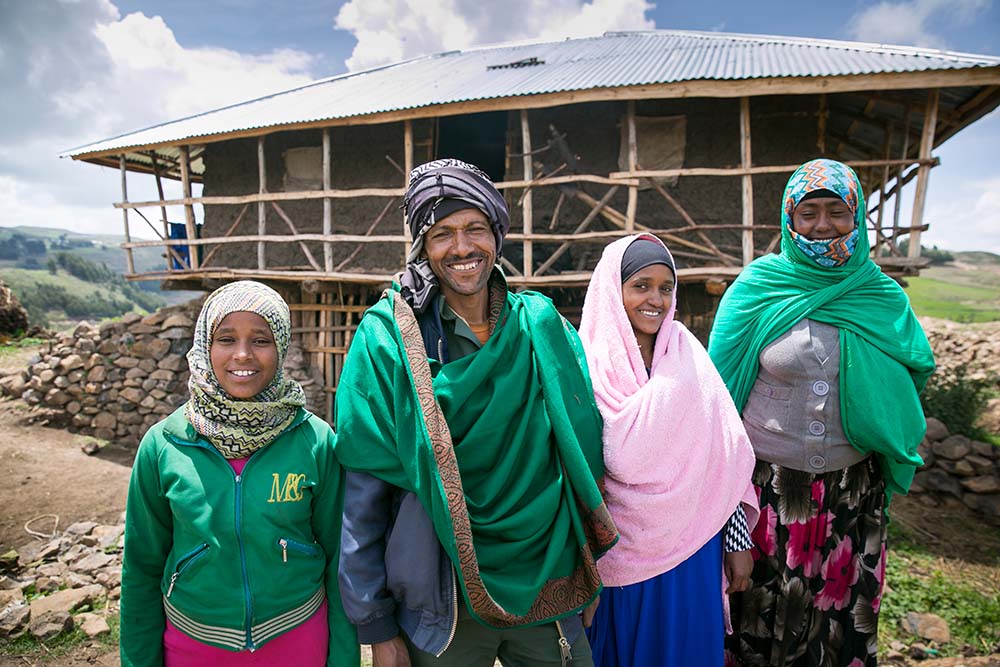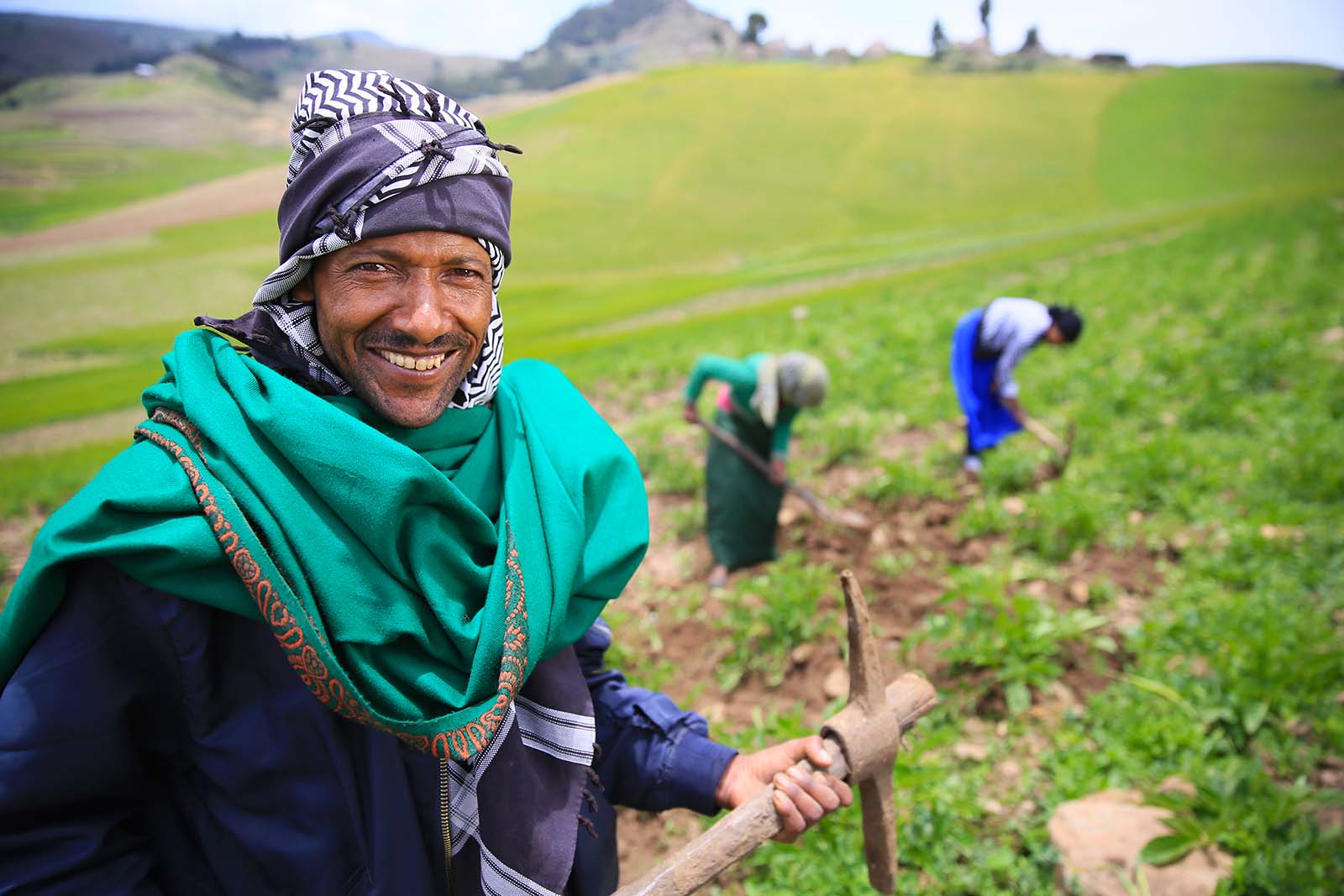Concern’s Irish-born roving reporter Kieran McConville meets a man growing a crop central to the culture and history of his native Ireland: potatoes. Find out how the humble spud is transforming lives and fighting hunger in the Ethiopian highlands.
Ali Assen finally cracks a smile, and it’s like the sun coming through the clouds. “Seriously?” I say, “you took six tons of potatoes out of this land?” He nods and laughs, obviously enjoying himself now. “Yes… 6,100 kilos, actually.”
That’s almost 7 tons.
Ali is a tough-guy farmer with a lot of hard mileage on the clock, fighting the vagaries of nature 12,000 feet up here in the Ethiopian highlands. We’re standing on a rocky hillside in Dawudo, South Wollo — part of the country’s Amhara region.

While we’re surrounded by the familiar foliage of potato plants (familiar to an Irishman, anyway), what’s unusual about this scene is that the staple crop in these parts has always been barley. The shift was an (ahem) uphill battle, but the results are helping to fight hunger in Ethiopia, and have prevented humanitarian food crises in one of the poorest and most remote parts of the country.
A tough start for tubers
As far as anyone can remember, barley was the norm in South Wollo. But, as Concern’s Mesafint Malak explains as he leads me on the hourlong trek into the hills of Dawudo, “Barley doesn’t really work well here. The yield is poor and it’s not very drought-resistant. Potatoes are much better.”
It’s been over a decade since one variety of potato (known locally as the “Irish potato”) was first introduced by Concern to the drought-prone northern highlands of South Wollo. “Initially, potato farming was a hard sell,” Concern’s Country Director Eileen Morrow recalls. “Families here were used to eating barley, and they were dependent on it for their livelihoods.”
Mesafint and his team took on the challenge of persuading the barley farmers of Amhara to change their crops. By focusing on the younger generations, they were able to convince 16 young farmers to pilot potato farming on small plots of land, nearly 2 miles above sea level.
Beyond small potatoes
Ali Assen was one of those 16 farmers. Up on the hillside, Ali recalls how he first planted 110 lbs of potato seeds and harvested 660 lbs of spuds.
“All the other farmers brought in more than me. I was disappointed,” he says. But instead of giving up, he decided to step up.
In 2014, he doubled his commitment and did better, bringing in 1,500 lbs. By then he felt like he was getting the hang of this whole potato thing and decided to go for broke. The end result was the 6.7 tons of spuds from a seed investment of 660 lbs — a darn good return in anyone’s books.
“We were eating two meals a day for six months, and going hungry for the other half of the year."
Reducing hunger and poverty
While visitors can struggle to breathe in the high-altitude hills of East Africa, the Irish potatoes thrive thousands of feet above sea level and amid droughts. In 2019, Concern received confirmation of the success of these spuds in the long-term: Growing from 16 adventurous farmers, the program has helped to reduce the hunger crisis in parts of South Wollo. A joint UN/Ethiopian government report determined that four districts in the region were no longer in “immediate need” of humanitarian assistance.
This dramatic improvement is the first of its kind since the hunger “hotspot classification” measurement system was introduced in 2000. And with a drop in food shortages, we also see an improvement in the local economy.
Barley in South Wollo fetches 6,400 Ethiopian Birr ($220) for every 2.5 acres. The same area’s equivalent of potatoes can sell for up to 62,000 Ethiopian Birr ($2,150), nearly 10 times the return.

The numbers that really matter
While the entire region is reaping the rewards, for Ali the big numbers pale in comparison to those that hit closer to home.
“We lived in a one-room hut… Now we live in a two-floor house,” he says, gesturing to where the family hut still stands. His profits from potato sales have empowered him to buy one ox, two cows, three horses, and a herd of goats.
They’ve also helped Ali’s family — his wife and two daughters — live better and healthier lives with a more nourishing and diverse diet. “We were eating two meals a day for 6 months and going hungry for the other half of the year,” he says of their time before growing potatoes. “Now we have three meals a day, every day of the year.
By the time he’s finished telling his story, Ali has one more thing: a very big, very well-earned smile.

Hunger in Ethiopia: The facts and the future
- UNOCHA estimates that 8.12 million Ethiopians are hungry (as of late 2019)
- 5.91 million Ethiopians need treatment for malnutrition
- Over 3 million Ethiopians need agriculture support in the face of climate change and resilience
- 80% of Ethiopia’s rural population depend on rain-fed agriculture, but the country is particularly vulnerable to weather-related shocks
- High levels of hunger in Ethiopia can be attributed to several factors, most notably drought, regional floods, and high levels of displacement
- Climate and conflict are both driving refugees and displacement within the country, which in turn affects food security for all
The good news, as seen in stories like Ali’s, is that humanitarian aid works. While a significant portion of the population still remains vulnerable to climate shocks, conflict, and hunger, childhood mortality and stunting have both declined substantially over the past seven years. In 2000, the country had a 52% undernourishment rate, which by 2017 had dropped to below 21%.
Concern has been in Ethiopia since we responded to the country’s 1973 famine, and has seen firsthand the transformations in hunger and poverty over the last four decades. Several programs across the country, including nutrition and livelihoods support, have helped decrease the population of Ethiopians living below the poverty line by 2.4 million in just 5 years, bringing us closer to helping the country meet its goal of having fewer than 3% of its population living below the poverty line by 2029.

